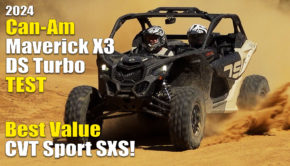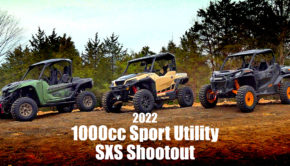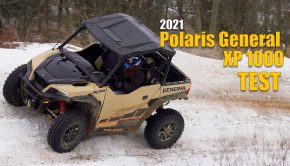Published on September 11th, 2023 | by Joe
2024 Yamaha Wolverine X2 1000 Test Review
2024 Yamaha Wolverine X2 1000 Test Review
For the first time since the Rhino ruled the trails, a Japanese manufacturer, Yamaha, more specifically, has regained dominance in a major SXS category from the North American based manufacturers with their outstanding RMAX 1000, winner of our inaugural 1000cc Sport/Utility Shootout. For 2024, Yamaha is adding a 3rd two-seat machine to their sport/utility lineup, the new Wolverine X2 1000. It’s designed to excel in tight terrain with well-rounded performance everywhere while delivering exceptional value for the price.
Bridging the gap between the Wolverine X2 850 and RMAX2 1000, on paper, the X2 1000 seems to take direct aim at Polaris’ entry level General 1000 and lower priced Can-Am Commander 1000 models. The New Wolverine X2 1000 is based on the compact, easy to see out of bodywork of the Wolverine X2 850, built on a modified and reinforced version of the 850’s chassis featuring longer-travel suspension and improved ground clearance. Based on consumer demand, Yamaha swapped out the 850’s engine and drivetrain for the one used in the RMAX 1000, the best in the business according to our test crew.
We recently joined Yamaha at Brushy Mountain Off-Road Park in Taylorsville, North Carolina for our first test of their new and exciting 2024 Yamaha Wolverine X2 1000.
Trim Packages
The Wolverine X2 1000 is available in two trim packages both featuring power steering, highly adjustable suspension, and cast aluminum wheels. The base model R-Spec retails for a very reasonable $17,599 with the more highly appointed XT-R model we drove at $19,999. The XT-R model features the addition of a sun top, automotive paint, Warn VRX45 4,500 pound winch, rear over fenders for added mud protection, a rear view mirror, and interior LED lighting
The 17,599 base model X2 1000’s most comparable competitor is the $2,400 more expensive Polaris General 1000 Premium at $19,999, which has been around for a while. The closest competitor to the more decked out $19,999 XT-R we’re testing is the Can-Am Commander 1000 XT. It, too, features a winch, roof, and 28” tires mounted on cast aluminum wheels, selling for $2,200 more than the Yamaha at $22,199. Still, the Commander XT’s shocks are more basic and far less adjustable than what comes standard on either X2 1000 model. Any way we look at it, either new Yamaha Wolverine X2 1000 model leads the way in value on paper. But, as we know, what really matters is performance, so let’s get into it!
Engine
The RMAX 1000 engine powering the Wolverine X2 1000 features a 999cc, liquid-cooled, parallel twin-cylinder design with 4 valves and double overhead cams per cylinder. Its 270° firing order helps increase torque and traction.
Delivered by fuel injection via dual 48mm throttle bodies, premium pump gas is recommended with the engine’s sport class worthy 11.2:1 compression ratio. It’s said to produce class leading horsepower and torque peaking out at 108hp at 8,500rpms with a 9,250 RPM redline. That’s 8 more HP than the General or Commander 1000’s, and 39 HP more than the Wolverine X2 850.
The Wolverine X2 1000 is drive by wire throttle equipped, like the RMAX, allowing for easy plug and play installation of Yamaha’s drive mode toggle switch, which was installed in our test units. It performs the same function as the round three position D-Mode knob used in the RMAX, providing Crawl, Trail, and Sport throttle modes. Yamaha is making this a very affordable upgrade at just under $100- a tremendous value!
With the exception of the shorter axles, most of the X2 1000’s drivetrain is borrowed from the RMAX. The RMAX’ engine braking equipped Yamaha Ultramatic CVT transmission used in the X2 features high and low forward ranges plus neutral, reverse, and park. A primary clutch handles engagement allowing constant drive belt engagement reducing wear. This allows Yamaha to cover the drive belt with their incredible 10 year warranty. The RMAX4’s 20g heavier primary clutch weights were used in the X2 to meet Yamaha’s desired power characteristic and sound output with the slightly smaller tires. Air intakes for the engine and CVT are located high under the hood, with CVT venting high enough that you’ll have water up to the seat bottom about the time you’d need to be concerned about getting the belt wet.
Beginning our ride, we were greeted with the engine’s familiar excellent low-end and midrange power. The Ultramatic CVT’s centrifugal clutch makes initial engagement butter smooth and predictable. The gas pedal’s shape was revised in 2021 making gas pedal modulation at low-speeds easier than we remember on our 2019 test of the 850.
The heavier clutch weights, combined with the slightly smaller tires, and lighter than the RMAX2 1000 resulted in very similar power characteristics to the two-seat RMAX. With most of the trail loop we drove comprised of tight, twisty trails, we began our drive in Crawl mode. This delays initial throttle response making it super easy to modulate while crawling over rock obstacles while still providing full power for climbs. Getting into the power later in the throttle throw also helps keep the engine operating at a lower roar making chatting easier.
D-Modes’ trail mode provides a very natural 1:1 throttle to engine response that we’re accustomed to on cable actuated throttles. It’s the mode that the X2 1000 operates at without the D-Mode switch installed.Trail provides well-rounded and relatively easy to manage power, although the 1000 engine is a bit of a ripper throughout the RPM range with the feeling even amplified somewhat in the lighter, more compact, X2 platform. Power is plentiful, and it runs seemingly flawlessly.
While Yamaha could have simply updated the chassis and suspension and had a much more capable X2, we’re stoked on the improved engine performance the RMAX power plant brings to the table. It’s on par with what we’ve come to expect from many machines in the naturally aspirated 1000cc sport SXS segment, providing performance that pushes you back in your seat. Topping out between 65 and 70 MPH the X2 1000 should easily be able to cruise fast, wide-open trails in the 50 MPH range without revving the guts out of the engine.
D-Mode’s Sport mode provides a harder initial hit when you crack the throttle, further adding to the thrill factor on take-off and exiting corners. Most aggressive drivers will appreciate Sport mode’s noticeable reduction in engine braking, which keeps the front end from diving when you let off the gas, helping suspension work better in the rough stuff. While the engine would be nearly perfect as is, for $100, we wouldn’t consider leaving the dealer without the D-Mode switch installed as it takes the engine’s performance and versatility to the next level.
Sound output seemed a little louder than we recall on the 850 with its more torque curve focused clutching. But the X2 1000 adds a whole lot more sport to its sport/utility intentions. It’s very similar sounding in pitch and volume to the RMAX2 and the sweet sound of the 1000’s engine only adds to the experience if you ask us.
The drive system features 2wd and limited-slip 4wd with a lockable front differential. This is the setup most consumers prefer and for good reason. With Brushy Mountain limited to 64” machines, we spent most of our time in limited slip, four-wheel-drive to maximize steering precision, keeping front differential lock in reserve for the most challenging rocky climbs. In spite of how challenging the course was, second attempts at the most technical climbs were rarely necessary by any of the editors in attendance.
Chassis and Suspension
The Wolverine X2 1000 received a track width increase from 59” to 61” thanks to longer A-Arms at both width ends. Arched lower A-Arms front help maximize ground clearance. The robust looking rear A-Arm design was based on the RMAX. The wheelbase remains unchanged and relatively compact at 83.7”. Overall, it has a slightly smaller footprint than the 64” width and 86.7” wheelbase of the RMAX2. The increase in suspension travel is substantial, up from 8.7” front and 9.3” rear on the 850 to 13.3 front and 15.5” rear on the 1000. The RMAX 1000 has only 9/10” more travel up front and 1.4” more travel out back.
Piggyback, nitrogen reservoir equipped Sachs ZF shocks feature preload and high and low-speed compression adjustments. They’re similarly appointed to the Fox shocks found on the nearly $25,000 RMAX Sport, which we tested back in 2022. It’s our favorite version of the RMAX due to its highly adjustable suspension allowing us to maximize the machine’s performance. The Sachs shocks are a surprisingly sporty appointment on an entry level priced sport/utility machine. Electronic power steering is found on all Wolverine and RMAX models.
Yamaha wisely outfitted the X2 1000 with a square wheel and tire setup, which allows you to carry one size spare tire or swap a wheel front to rear in the event of a flat. A square setup also typically provides sportier handling characteristics. The OG Maxxis Bighorn tires were chosen for their ability to perform in various terrains without weighing a ton like many modern SXS tires. One inch taller than the tires used on the Wolverine X2 850, 28×10” tires were used all around, mounted on Yamaha tuning fork inspired 14” cast aluminum wheels. The added width and taller tires provide 12.5” of ground clearance. That’s 1” more than the X2 850, 1” more than the base model 62.5” wide General and ½” between the 27” tire equipped Commander DPS and 28” tire equipped Commander XT.
The Wolverine X2 850 chassis was modified to accept the RMAX engine and drivetrain. Higher upper shock mounts allow for the use of longer shocks and the added suspension travel. The frame was strengthened throughout to deal with the added power, leverage, and higher speeds the 1000 delivers. Yamaha also borrowed the spindles and wheel bearings from their 2016-2018 YXZ1000R sport SXS to meet the demands of the 1000’s added power and increased capability. The underside of the chassis is protected by welded steel skid plates. Kickouts are found on the sides of the frame for added protection along with full coverage steel skid plates. We’d be looking to protect them both with accessory skid plates and tree kickers if we were going to beat on our personal machines like we did Yamahas. A steel front bumper is standard.
Remarkably, the X2 1000 is only claimed to be 38 pounds heavier than the X2 850. Comparing the weights of the base model Wolverine X2 1000, General, and Commander, the Commander XT has a claimed weight of 1,675 pounds; the General Premium is a claimed 1,425 pounds, but those are dry weights. The X2 1000 R-Spec has a claimed wet weight of 1714 pounds full of fuel and all fluids making actual weights hard to compare, but we’d expect the X2 to be a little heavier than the General, especially the Genera, and more in line with the Can-Am. This is completely acceptable considering the X2 delivers more horsepower, fancier suspension, a bumper, winch and a reputation for durability.
From a casual pace to pushing the limits on the tight, twisty, ups and downs of Brushy Mountain, the X2 feels agile and light on its feet, while being stable and precise. The 1000 steers accurately both on and off the gas. Front-end steering is precise and the back end will come around a little more quickly and easily than the RMAX, if you have the room to pitch it out. The narrower width and wheelbase certainly make the X2 1000 a bit more agile than the RMAX2. We’d expect the RMAX to have an edge in technical crawling situations due to its super long rear suspension travel and lack of a rear sway bar, but it’s difficult to determine how much more stability its wider, longer chassis provides. The X2 features sway bars at both ends, which let the suspension to still offer a decent articulation while doing very well at preventing the trophy truck style body roll we experienced on the RMAX2. The X2 1000 feels very planted and confidence inspiring.
Out of the box, suspension performance was very well rounded. It does well at taking the edge off small bumps, offering plenty of mid-stroke support as we want from a sport focused machine. It never feels willowy as a utility suspension can, keeping you up in the travel, maintaining ground clearance while preventing unwanted diving or rolling. Mid-size and larger hits are very well managed. We only bottomed a couple of times on deep, square edged g-outs from water ruts crossing the trail. Getting a little air on some of the more ramp shaped water breaks was easily possible, and the shocks did well at providing a smooth touch down on landing.
While a one-inch increase in ground clearance doesn’t sound like much on paper, combined with the added suspension travel, it seemed far more significant out on the trail, only framing out on a couple rock ledges. With time to tune, a little more low-speed compression might possibly have held the car up a little more in the travel while a little less high-speed compression damping could have softened small, high-speed hits even more. Although, we are not sure how much more we can expect from stock shocks, their performance seemed spot on for the machine’s power and the terrain we tested in.
Steering is light with just enough feedback that it remains natural feeling, never nervous. It did well at filtering out harsh feedback from unexpected impacts with rocks and stumps sticking out of the dirt walls alongside the trails. We’ve been saying that Yamaha’s power steering is the best for years, and the chatter among the other editors confirms that many of us feel that way. There’s no need for various power modes; it just works right.
Squeaks, knocks, and rattles in the chassis were unheard-of. Overall handling and suspension performance was outstanding on the tight to intermediate spaced trails we drove on, and no manufacturer lets you put a machine to the test like Yamaha, a testament to their confidence in their products.
Brakes
Hydraulic disc brakes featuring 207mm rotors and dual piston calipers at all four corners. As usual, braking power and feel were both excellent with no hint of fade despite our ample use of the brakes.
Interior and other Details
Step inside the X2 1000 and the interior’s ergonomics feels nearly identical to the RMAX from the seat. There’s plenty of legroom for a 6 foot tall driver. The seats are identical to those used in the RMAX R-Spec with a slider adjustable driver’s seat. The tilt adjustable steering wheel is borrowed from the other Wolverine and RMAX models. It’s comfortably compact with a rubber coating providing predictable grip in dry or wet conditions. As we mentioned earlier, the previously revised gas pedal was a big upgrade in aiding throttle modulation at low speeds. The metal passenger side grab handle is in a comfortable enough location, but lacks the easy adjustability and ergonomics of the T-shaped passenger grab handle found in the RMAX.
Like it or not, the shoulder bolsters remain. We didn’t notice ourselves getting snagged on them as easily as we did in the past after Yamaha increased the door area entering the cab back in 2021. Some of our larger test drivers complained about them in the RMAX, so if you have super wide shoulders, you may not be a fan. They are nice to lean on a bit on off-camber trails.
The center console with rubber plugged cut-outs for adding accessory switches, the shifter, parking brake lever, and soft touch points were all carried over from the RMAX adding to the interior’s comfort and refinement. The digital display remains center mounted, although we’d prefer it to be mounted in front of the steering wheel. There’s already a cut-out in the dash in addition to speaker pods in the doors allowing for easy stereo installation. The full coverage half doors close solidly with no rattles and the interior mounted handles that open the doors feel solid and robust.
Interior storage is provided by the RMAX center console storage box featuring a lid that’s unique to the X2. There’s a small tray in the front of the center console in addition to a passenger side glove box.
While the dash lacks the more refined automotive style look of the RMAX, sight lines out of the X2 1000 are outstanding. They’re the best in the sport utility class, letting you easily pick or rip your way through tight, technical situations. The hood’s steep slope makes the view of the trail in front of the car virtually uninhibited. It’s extremely beneficial approaching steep, technical descents.
Led Headlights and tail lights with reverse lights are modern and very adequate for cruising the trail at night.
Utility Capability
The hydraulically assisted tilting cargo bed has a 600 lb carrying capacity like the other units in its class. It features tie down hooks in the bottom making securing cargo easier. Of course, Yamaha has a ton of accessories ready to enhance the X2’s cargo carrying capabilities in addition to an expansive line of accessories of all types, borrowed from the X2 and RMAX lines.
A two-inch hitch receiver at the rear allows you to take the hitch from your truck to your SXS and provides a full ton of towing capacity; 500 lbs more than the General 1000.
Conclusion
The Yamaha Wolverine X2 1000 is an outstanding new Sport/Utility SXS that seems underpriced in the current market. It delivers all the performance most SXS enthusiasts would ever need on tight to intermediate trails. It’s quick, thrilling, handles beautifully, and offers plenty of versatility for working or adventuring. As we alluded to, its highly adjustable suspension makes it seem like a mini RMAX Sport to us, with the same power and similar capabilities for around $7,300 less leaving a lot of money on hand to do a dream build with accessories on the X2.
If we did our 1000cc Sort Utility Shootout again in 2024 and entered the new Yamaha Wolverine X2 1000 into the mix, it would certainly give all those 64” wide, more premium machines a real run for their money for a remarkably lower price.
We typically shy away from making bold statements that can come off as outrageous, but, in this case, we have no choice. No other sport utility SXS on the market delivers more performance for the price than the Yamaha Wolverine X2 1000. Now, they not only have the top performing and most refined machine in the class with the RMAX 1000, Yamaha has delivered the best value going in the Sport/Utility segment with the new 2024 Wolverine X2 1000!
2024 Yamaha Wolverine X2 1000 Ratings
Summary: No other sport utility SXS on the market delivers more performance for the price than the Yamaha Wolverine X2 1000. Now, they not only have the top performing and most refined machine in the class with the RMAX 1000, Yamaha has delivered the best value going in the Sport/Utility segment with the new 2024 Wolverine X2 1000!










